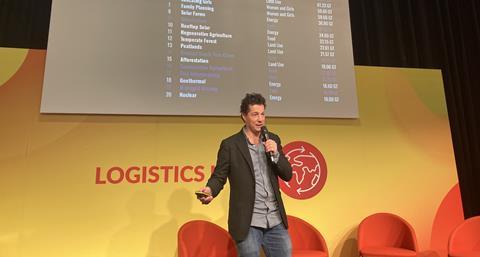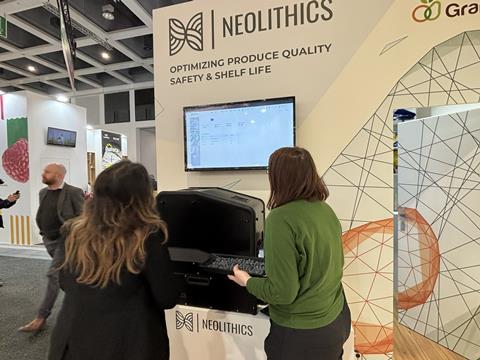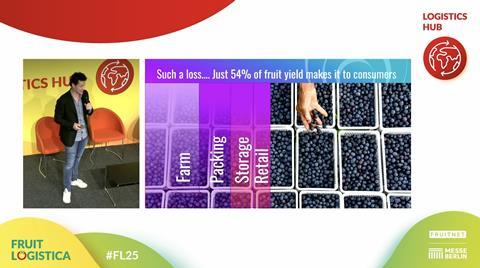A staggering 46 per cent of fruit never reaches the consumer, according to David Kat of Neolithics, who spoke at Fruit Logistica about the importance of data collection and data sharing to reduce waste along the produce supply chain

Despite the best efforts of many producers, packers and retailers, the lack of alignment and collaboration between the different parts of the supply chain continues to engender inefficiencies and waste, according to David Kat, VP business development at Dutch AI agri-tech firm Neolithics, presenting on the Logistics Hub at this year’s Fruit Logistica.
“Almost half of fruit is lost somewhere along the chain,” he said, “be it at the farm, in packing or during storage, and that’s before it’s even been presented to the consumer in retail. They all have their own reasons why this happens, but the overarching reason is, we’re not driven to collaborate for food efficiency.
“Reducing food waste is one of the most impactful ways of reducing our greenhouse gas emissions,” he explained. “The food industry is responsible for a quarter of global emissions, and we are losing up to 40 per cent of all food produced globally.”
Kat cited a meta study by non-profit organisation Project Drawdown whose top 20 most impactful solutions to reduce emissions included eight that directly concerned the food system – steps that could not only address these environmental challenges but also provide profitable opportunities for businesses.
“If you’re throwing away food, you’re not just losing the product; you’re losing water, inputs and money,” he said. “We cannot afford to keep doing this.”
The reward for change is potentially huge, he pointed out: if the food sector is valued at around €10tr, food waste alone must be costing in the realms of €5tr, in terms of monetary value lost and climate harm caused.
Embracing data
A crucial part of the needed transformation, Kat believes, lies in embracing data at every stage of the supply chain. “One of the elements that can really help this move is to have uniformity – a uniform understanding of the quality along our value chain,” he said. “So at the moment, if you have an avocado growing on a tree in Peru, that is an individual source of data. If you have an avocado lying in an Edeka store here in Berlin, that is another source of data. In the current value chain, those two are not being connected.
“But in fact they are connected, because the dry matter in an avocado on a tree, the Brix of a mango that has just been harvested, the pesticide residue on a blueberry that’s on its way from Chile to Europe – all of that is data and data that can be connected.”
Kat’s company, Neolithics, has developed technology capable of scanning produce — such as avocados, pineapples or mangoes — at different stages of the supply chain, providing critical insights into the product’s quality and helping producers make better decisions on when to harvest, how to store and ripen, when to ship, and how to extract the greatest value based on an individual fruit’s quality.

“At Neolithics, we can actually see inside any fruit using a device that looks like an airport scanner,” said Kat. “It shows the dry matter distribution in an avocado, or the Brix in a pineapple, or even the starch distribution in a potato travelling on a conveyor belt in a factory just before it’s turned into fries. And if you have that kind of data, and if you collaborate with different sources, different players and different suppliers, it can actually tell you when to harvest, how to ripen, how to optimise your logistics.”
New approach to quality control
Kat said he envisions a more transparent, data-driven supply chain where quality control is less destructive and more pinpoint. “At the moment, if you’re assessing a batch of blueberries, you’re sampling just a minute portion and assuming it’s representative of the entire shipment,” he explained. “This method is highly inaccurate, especially for products like blueberries and avocados. But with enhanced tracking and more precise data, we can improve consistency and reduce waste.”
The potential benefits of such systems go beyond environmental impact; they also offer significant economic advantages. “Improving quality control and reducing waste not only cut emissions, they boost profit,” said Kat. This can lead to more consistent products for consumers, better yields for growers and stronger relationships across the supply chain, inspiring greater loyalty, he suggested.
“When consumers buy blueberries,” he said, “when it comes to quality, they are putting their trust in someone, but it’s a bit of a gamble. And that gamble is not paying off, because if you buy a box of blueberries or an avocado that don’t meet your expectations, you are not going to buy them for another– the average I hear from IBO and WAO is about three months. So consumption is definitely harmed by the fact that we are not collaborating, that we’re not creating the data and we’re still wasting a tremendous amount. Enhancing the consumer experience brings more rapid repeat purchases. That grows the category.”
On waste in the avocado category, Kat said that he’d done some calculations of his own. “I estimate that for every avocado you buy as a consumer, about 10 per cent of the price is actually to make up for all the fruit lost along the way,” he revealed. “So the consumer is paying for the inefficiencies in the chain. Not only are they spending their money, they’re also paying for it in the impact on the climate, which is then leading to decreased yields and increased risk. So it’s kind of a vicious cycle spiralling downwards.”
Kat stressed that the food industry stands as perhaps the largest, most data-deprived sector on the planet. Only by working together can the industry begin to reverse the current cycle of waste and inefficiency, he cautioned. “The IFPA’s Supply Chain of the Future is an initiative that brings that sort of collaboration about,” he said. “It’s organising a virtual Collabathon on 25 February that’s open to the industry.”
“I think the real future is in getting a uniform-ish type of data that we can all share,” he added, “because then we will actually be able to leverage those insights using different kinds of technologies around that same fruit for a more consistent product, a satisfied customer and a healthier industry.”




